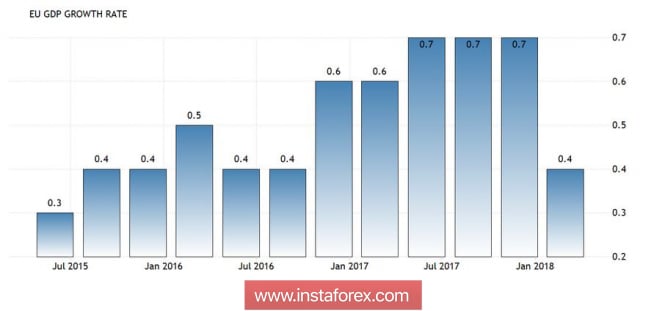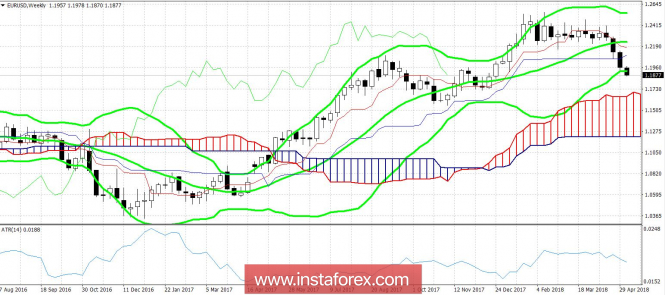The dollar continues to systematically advance across the market, ignoring many of the potential risks. The yield of 10-year US bonds is kept at a high level. In May, this indicator did not fall below 2.9%. In turn, the EUR/USD pair also follows the general trend, demonstrating the southern trend.
Yesterday, the pair tried to break through and consolidate below the level of 1.1880 (though, unsuccessfully) and today, the EUR/USD bears again stormed this intermediate-key level. Given the fundamental picture, the dollar still sells this target, heading to the bottom of the 18th figure. To date, almost all factors play in favor of the US currency, while the existing risks are hypothetical.
Today, in the international economic conference in Zurich, the head of the Federal Reserve, Jerome Powell gave a speech. Here, it is worth recalling that following the results of the last meeting of the Federal Reserve, Powell did not communicate with journalists, so the market today expected additional comments on the May meeting. However, the head of the Federal Reserve did not live up to these expectations. He limited himself to general phrases, and basically said that the policy of the Central Bank should be fairly predictable. He indicated that the actions of the regulator should not surprise or shock the markets. Powell stressed that the Fed is successfully coping with this task. The head of the Federal Reserve also said that some investors and financial institutions "may not be ready" to tighten monetary policy, although this process has had a limited impact on capital flows in recent years.
As we can see, the speech of Jerome Powell was not specific, and his hints were too veiled for any significant organizational conclusions. He did not comment on the text of the closing statement at the last meeting, assessing the likelihood of a fourfold rate hike this year. Therefore, it is not surprising that the dollar bulls actually ignored this speech, considering the absence of criticism as a positive signal.
The European currency in the EUR/USD pair is forced to submit to the hegemony of the dollar due to its own weakness and pervasive pessimism. The economy of the alliance is showing a slowdown, and this fact increasingly reminds it of itself. Key indicators, such as GDP and inflation, were below the weak forecasts. The growth of the European economy slowed in the first quarter to 0.4% with the GDP growth in France, Belgium, Austria all declining. The main consumer price index also turned out to be in the "red zone" at 0.7% instead of the expected 0.9%.

Not surprisingly, on this background, investors' expectations have collapsed to the lowest values since January this year. The corresponding indicators from IFO and ZEW indicate the pessimism of European investors, all the more so amid growing uncertainty around the prospects of Brexit. The last puzzle in the picture of general pessimism was the indicator of production orders in Germany, which showed a significant reduction.
The rhetoric of ECB representatives also exerts pressure on the euro. For example, the senior economist of the European Central Bank, Peter Praet, said today that the EU economy still needs monetary incentives since the latest data indicate a "slowdown" in the economy despite steady expansion. Such a contradictory view did not surprise traders, because Praet is a supporter of soft policy, and his position on this issue is fairly consistent. In turn, the head of the Belgian Central Bank strengthened bearish sentiment on the pair, allowing the probability of shifting the timing of the completion of QE and raising the rate, "taking into account the latest macroeconomic indicators."
All this suggests that the European currency does not exist and in the near future will not have its own arguments for its recovery. The dollar, in turn, enjoys support from almost all sides: the key macroeconomic indicators are rising, treasury yields are kept at a high level, and the terms of monetary policy continue to be gradually tightened.
And here it would be possible to recommend with confidence the traders to open short positions on the EUR/USD pair if not for one "but". Today, Donald Trump will announce his decision on an agreement with Iran on the nuclear program. The US president will either prolong the "freeze" of sanctions or break the deal, resuming the sanctions. The consequences of the second option are difficult to foresee now: for example, the president of France did not exclude even the scenario of a military conflict. Therefore, if Trump still decides to take radical action, the dollar may be under strong pressure. Events will develop dynamically and unpredictably, which will cause strong volatility in the markets. Given this factor, it is recommended to make trading decisions after the announcement of the American verdict.

